The Huawei MateBook X Pro Review: Calling Out The Competition
by Brett Howse on June 27, 2018 8:00 AM ESTGraphics Performance
Here’s where the Huawei MateBook X Pro stands out from the crowd. Most Ultrabooks rely on Intel’s UHD620 graphics, Huawei added in the NVIDIA GeForce MX150 GPU to the mix. With 384 CUDA cores, and 2 GB of GDDR5, the MX150 adds a bit more punch and it’s the first time we’ve had a chance to test it in a notebook.
One of the biggest advantages of having a discrete GPU is that you’re no longer forced inside of the thermal envelope of just the CPU. NVIDIA doesn’t release the TDP figures of its mobile chips, but you can expect the MX150 to likely have at least 15-Watts to itself. This also helps the CPU by not having to clock down as aggressively as when the GPU is integrated. Of course, this also requires adequate cooling to keep both chips in check.
To complicate matters, NVIDIA offers two different MX150 parts set up for different TDPs. Since this is in a thin and light ultrabook, it's perhaps not surprising to see that it features the lower speed version which has a maximum boost frequency of 1038 MHz. The higher TDP version for thicker laptops can boost to around 1500 MHz.
We’re in the process of transitioning to a new suite of games for 2018 and beyond, but because this laptop isn’t a gaming laptop, the games in our existing suite are more than demanding enough. But first, the synthetics.
3DMark
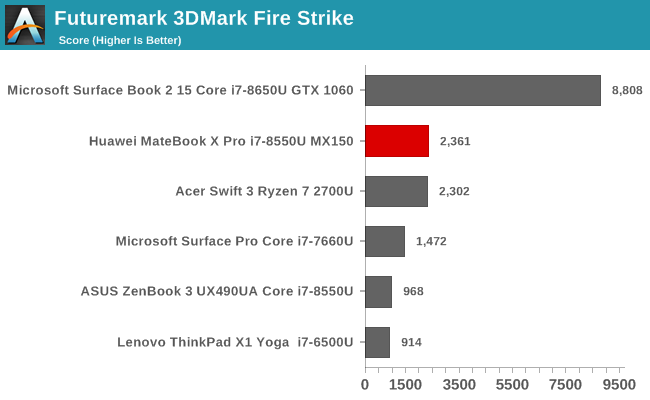
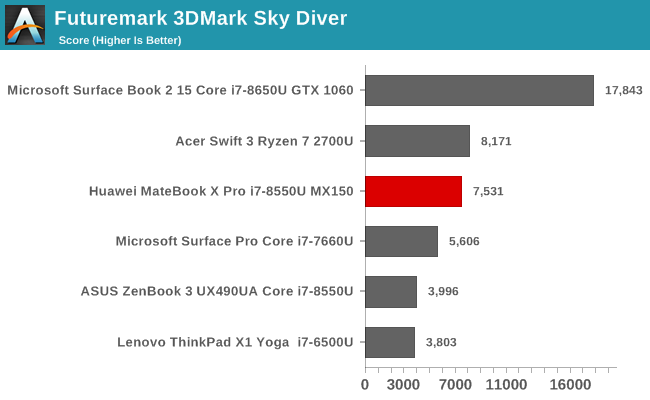

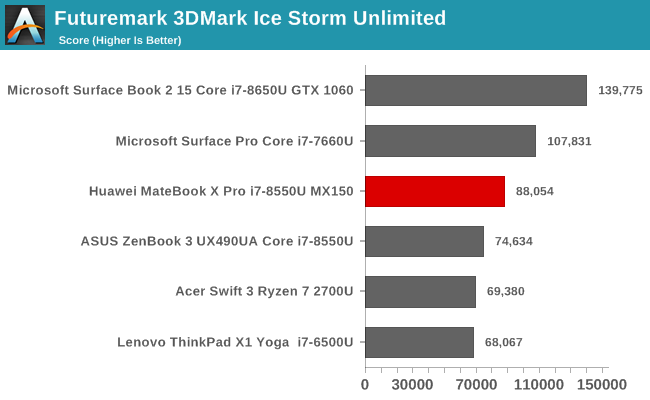
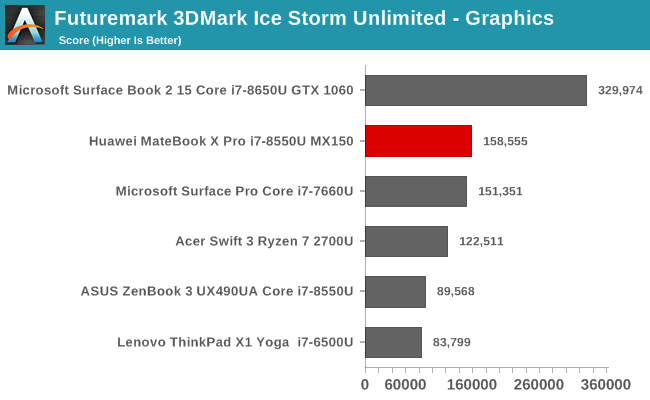
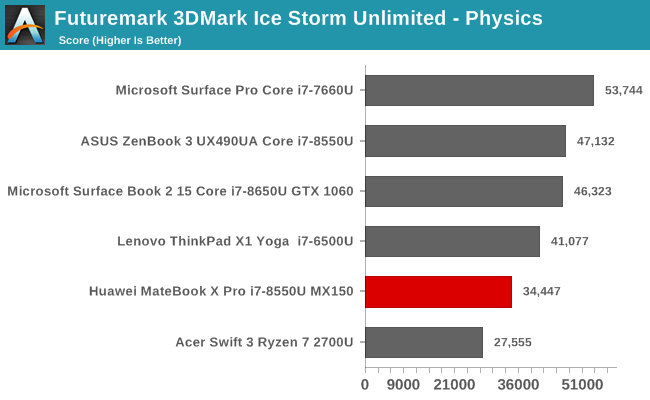
FutureMark’s 3DMark offers several tests with a variety of GPU demands. Fire Strike is the most demanding, then Sky Diver, Cloud Gate, and finally Ice Storm Unlimited which is designed for smartphones and tablet-class GPUs.
The NVIDIA MX150 offers a significant performance gain from the integrated GPU alone, and the more demanding the test, the larger the benefit. Fire Strike is an impressive 143% faster on the Huawei MateBook X Pro than the ASUS ZenBook 3 with the same CPU but just the UHD 620 graphics. On top of that, the MX150 also squeaks past the AMD Ryzen 7 2700U powered Acer Swift 3 with its Vega graphics.
GFXBench
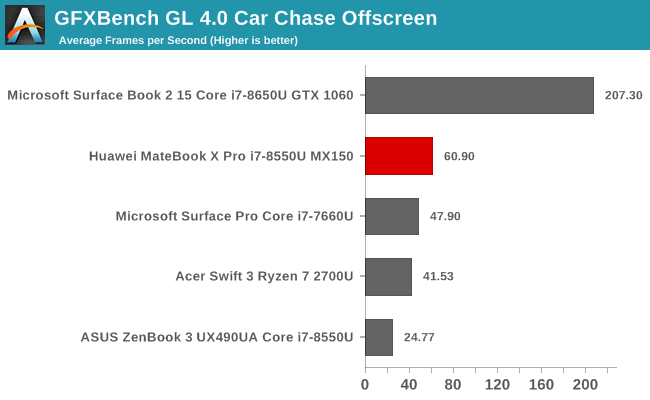
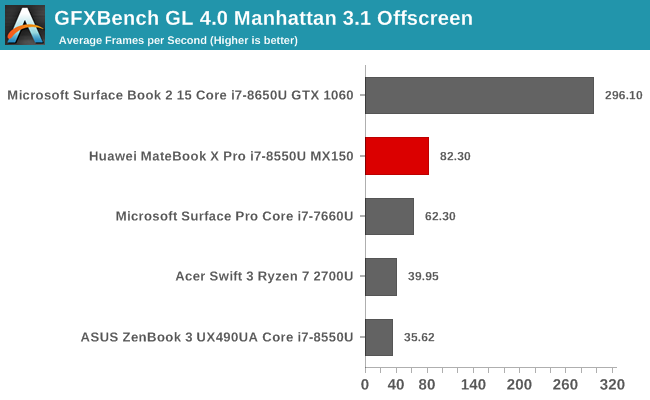

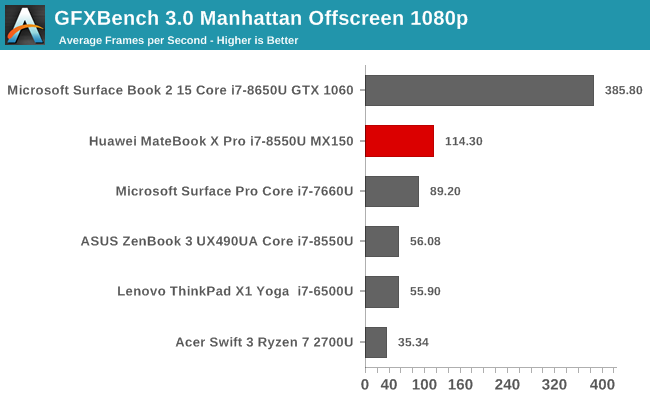
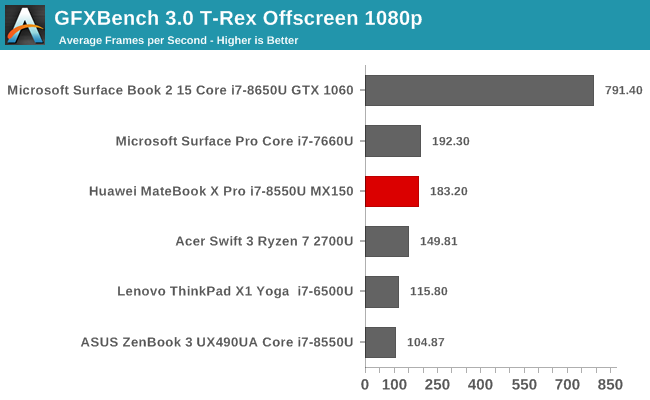
Kishonti’s GFXBench is a cross-platform test that uses OpenGL on the desktop, and since most new PC games don’t use OpenGL, it’s really just a chance to see how the OpenGL drivers are for a GPU. Once again the MX150 does very well here compared to integrated alone.
Dota 2
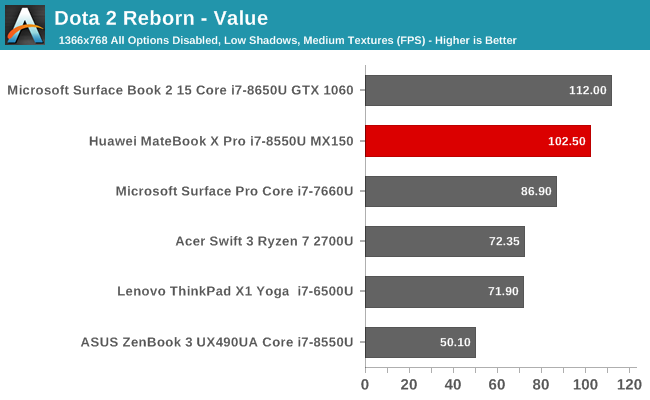
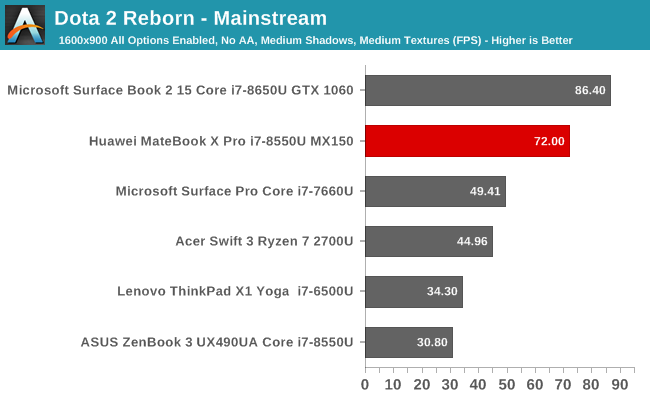
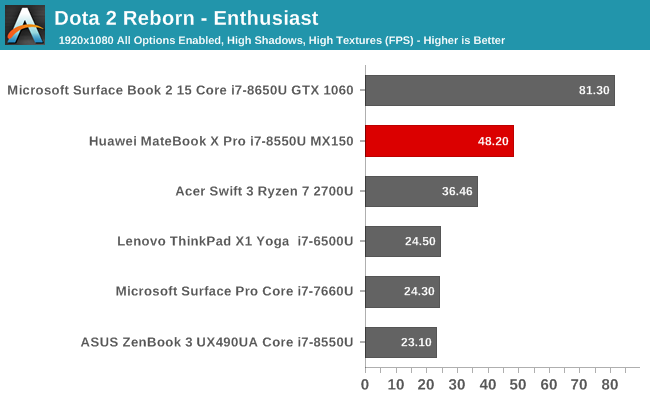
Valve’s Dota 2 is one of the most popular arena games around, and the engine is dynamic enough that it can be run fairly well on even low-end machines, making it a great game to test on an Ultrabook. The MateBook X Pro does very well on this test, easily outclassing the integrated GPUs on both the Intel and AMD laptops. The gap over the AMD Vega mobile likely has a lot to do with Dota 2 being a fairly CPU limited game, and having a separate TDP for the CPU and GPU like the MateBook does is a nice benefit.
Tomb Raider
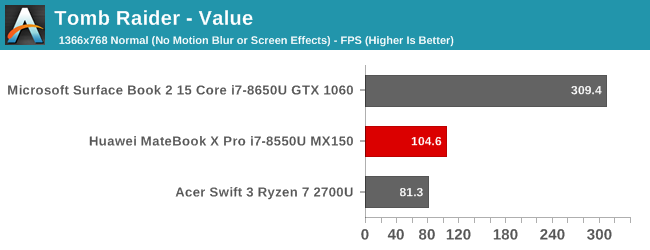
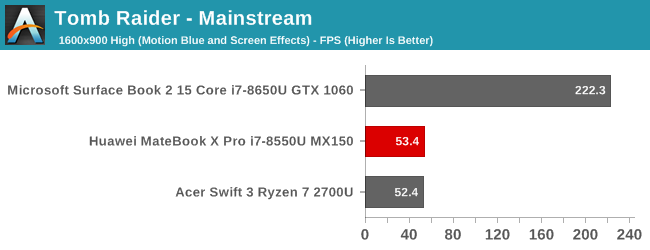
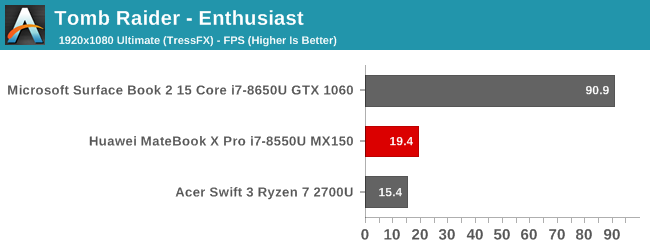
Although several years old now, the original reboot of the Tomb Raider franchise can still be punishing to laptop GPUs. At low to medium settings though, the MX150 does very well on this game, and is more than just playable. It once again edges the Ryzen 7 2700U in the value settings where the CPU is a bigger factor, but that gap closes once the GPU is taxed a bit more in the medium settings. At our Enthusiast levels, no Ultrabook is playable.
Rise of the Tomb Raider
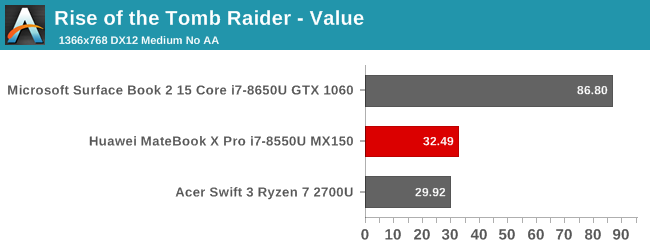
The sequel to Tomb Raider is even more demanding, and at our value settings is just averaging 30 FPS, meaning you’d really have to turn this game down to even have a chance to play it on an Ultrabook.
Civilization VI
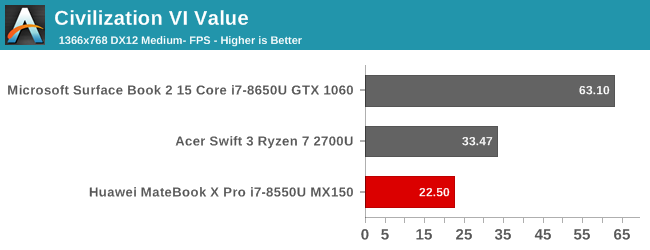
This game can normally be played with framerates that aren’t anywhere near a First Person game, thanks to the turn-based design of Civilization VI, but there were difficulties getting the game to run at our 16:9 resolutions we normally use, and the game was almost unplayable at even 1366x768. This is one of the issues you run into with an aspect ratio on the display which isn’t standard.
Bioshock Infinite
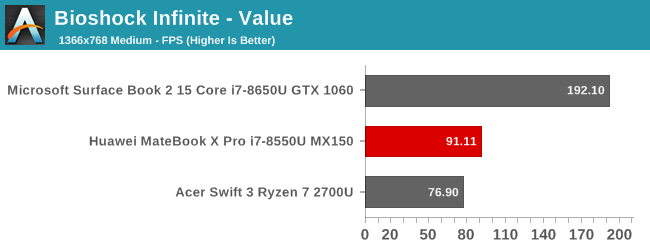
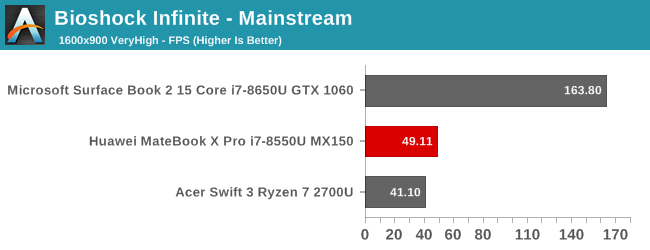
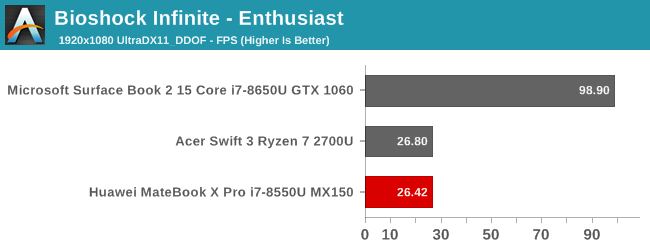
Like Tomb Raider, this game is several years old now but can still bring laptops to their knees, and we see that again with the MateBook X Pro. At low resolutions, it does very well, but on our enthusiast levels you’d not be able to play the game.
GRID Autosport

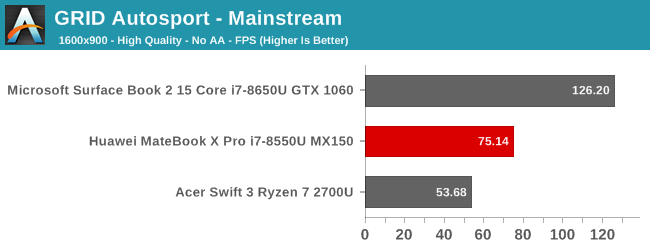
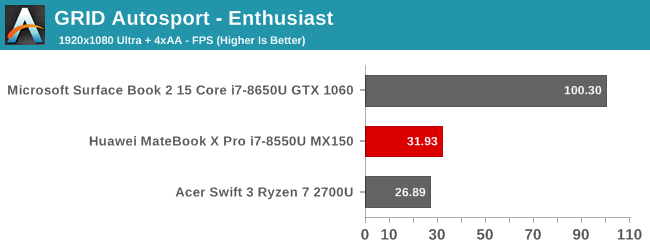
This game is heavily CPU bound, and you can see the gap between the MateBook and the AMD Ryzen 7 2700U powered Swift 3 is quite large. Once again, having separate TDPs helps, as does the extra performance from the Kaby Lake Refresh CPU.
GPU Conclusion
It was great to finally get a chance to test a laptop with the NVIDIA MX150 GPU inside, since Pascal has been such a big update on the bigger GPUs, it only makes sense that it’s also a big update over the GT 940 and other low-end GPUs NVIDIA offered previously. Offering this GPU in the MateBook X Pro provides it significantly more GPU power than Ultrabooks which rely on just the integrated Intel graphics, and it even outperforms the Vega GPU in the Acer Swift 3. There’s no free lunch here though, and Huawei would have had to pay extra for the GPU, and the bill of materials would also have to include the extra space and cooling required.
The MateBook X Pro isn’t a gaming laptop by any means, but with this small increase in GPU performance, it does at least give you the option.


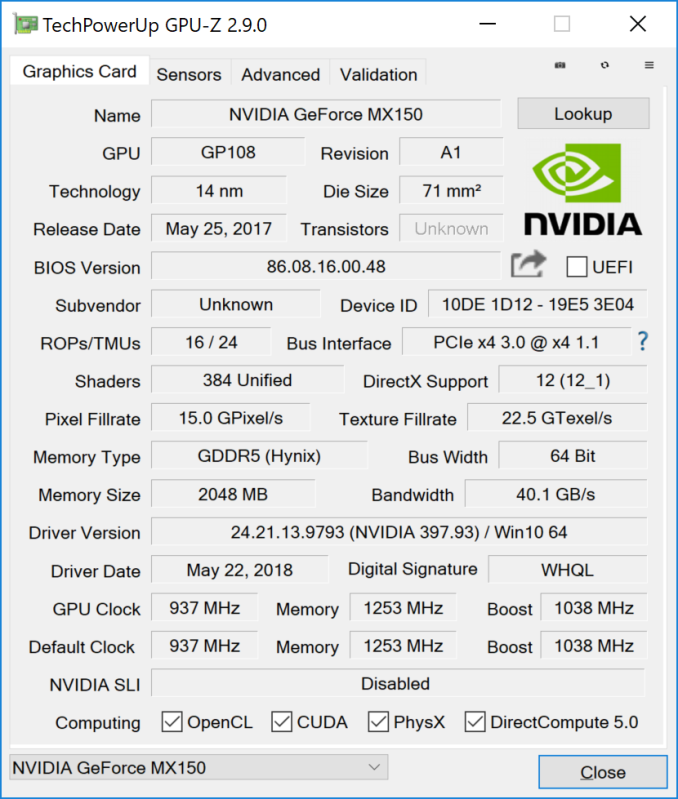








77 Comments
View All Comments
MrSpadge - Wednesday, June 27, 2018 - link
I really like the meaningful and fairly priced separation between the i5 and i7 model - keep it simple and the upgrade noticeable to the user.SirCanealot - Wednesday, June 27, 2018 - link
Actually, I was thinking the same thing! For the sake of $300 I can upgrade almost everything on the system. For $300 to do that, it's quite a 'may as well' situation! :)DiscoDJ - Wednesday, June 27, 2018 - link
I know the internet is international in scope, but I do find it interesting that this article doesn't even mention the security issues the U.S. Govt. (whatever you may think of it, right now) has with Huawei or ZTE. Is there an article on this site somewhere that dismisses these concerns as unfounded?RedKiwi - Wednesday, June 27, 2018 - link
Reading through the summary of the House intelligence report on Huawei and ZTE, it seems more of a "not worth the risk" type of situation. Investigating hardware provided by Huawei and ZTE was out of the scope of the investigation. The House only questioned their involvement with the Chinese government. Both companies were unable to provide a satisfactory answer to the committee. By not allowing Huawei and ZTE to sell telecommunications equipment to US carriers, it removes the possibility of snooping even if there is no risk in the first place.I do believe consumer hardware Huawei makes is safe for general use. It might not be worth it for the government to risk.
On a side note, I wish some of these decisions would be made in other parts of the US government such as environmental laws.
vanilla_gorilla - Wednesday, June 27, 2018 - link
That's one of the most reasonable replies to that question I've seen.But we can't ignore the fact that in 2017 ZTE plead guilty to illegaly exporting US technology to Iran and North Korea.
Let me say that again: Iran and North Korea. In violation of international trade sanctions.
Then when the US called them on it, they agreed to reprimand employees and pay a fine. Instead, they only fired 4 officials and provided bonuses to 35 others. That's why the US Department of Commercen banned companies from buy ZTE products.
I don't think there's much more anaysis the government needs to do. Security is all based on trust and ZTE has zero. I wouldn't trust them as far as I could throw them.
ianmills - Wednesday, June 27, 2018 - link
Well the results sound about par for how the US handled their own 2009 financial crisis hahainvinciblegod - Wednesday, June 27, 2018 - link
"But we can't ignore the fact that in 2017 ZTE plead guilty to illegaly exporting US technology to Iran and North Korea. Let me say that again: Iran and North Korea. In violation of international trade sanctions."You say that like it's a super surprising thing but you'll be surprised to learn that many companies actually make a cost benefit analysis and more often than would be expected choose to illegally export US parts to those countries. They just know that if they get caught they will pay a fine and then everything is fine. Just search "companies that violate sanctions to iran" on google and you will see how many companies do it and get caught. ZTE obviously miscalculated on how much they could get away with in the plea deal.
invinciblegod - Wednesday, June 27, 2018 - link
Also, ZTE is not Huawei.Samus - Thursday, June 28, 2018 - link
LOL I was about to say the same thing.Oxford Guy - Tuesday, July 3, 2018 - link
Yep. If the benefit (the profit) outweighs the slap on the wrist (the cost) then why wouldn't any corporation go for it? Corporations are not people. They're financial mechanisms designed to enrich some people. They just happen to have real people to do some of that work (along with AI, robotics, etc.).